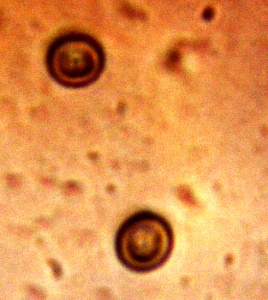Human Blood vs. Synthetic Blood :
The Path to the Blood Clot
Clifford E Carnicom
Dec 14 2023
The synthetic biology identified by Carnicom Institute (CI) under the name of Cross Domain Bacteria (CDB) is the primary agent responsible for increased human blood clotting over recent years. This conclusion is based upon extensive observational and analytic study of the CDB under controlled conditions.
It is to be reiterated that the welfare of the human race is at stake within these discussions. Please see previous papers over recent months and years to understand the basis of this reality.
There are three minimum components to the synthetic blood clot: synthetic blood cells, a synthetic protein complex (proteome) and an insoluble synthetic polymer matrix. The addition of embedded CBD produced filaments within the clot (as has been shown previously) only extends the damage further. Each of these components has now been isolated and identified within CI research.
This paper will outline the progression that leads to the conclusions above . Comprehension of this structure is a prerequisite to the logical development of inhibitory and beneficial mitigation strategies of the future. We are decades behind the curve in this process as it stands. Progress can be made, nevertheless, under limited means.
Some papers cannot be discussed in a few paragraphs; this is one of them. A summary form may appear at a later time. Note: Technical portions of the work may be enclosed in parentheses, and they can be read per preference.
For historical context of CDB nomenclature, please see Cross-Domain Bacteria Isolation, May 2014.
_____________________________________________
_____________________________________________
Five sections of this paper exist. They are:
I. A Visual Comparison Between Human Blood and the CDB Synthetic Blood
II. A Basis Established for the Increased Coagulation of Human Blood
III. The Clotting of Blood
IV. DNA Production
V. Beyond the Blood Clot
_______________
Section I: A Visual Comparison Between Human Blood and the CDB Synthetic Blood:
Summary of Section I:
What is known, then, is that the synthetic blood shares many similar properties with human blood, especially that of hemoglobin, but that it also is most certainly not “human blood”. It is a genetically engineered blood (xenobiotic) that interacts with and affects blood in ways that are highly detrimental to human health. This includes blood coagulation and blood clotting.
_______________
Let’s start by looking at “normal” blood vs. CDB created synthetic blood cells.
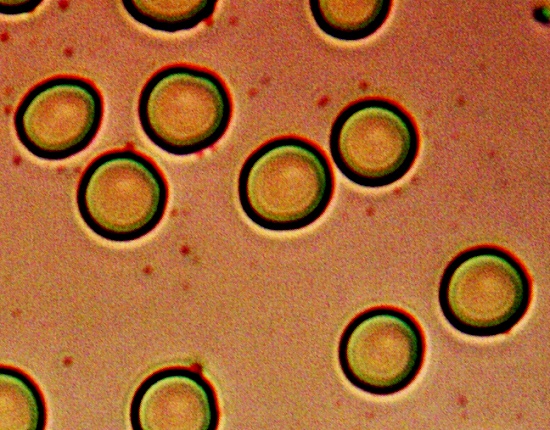
“Normal” Human Blood
Original Magnification 3200x
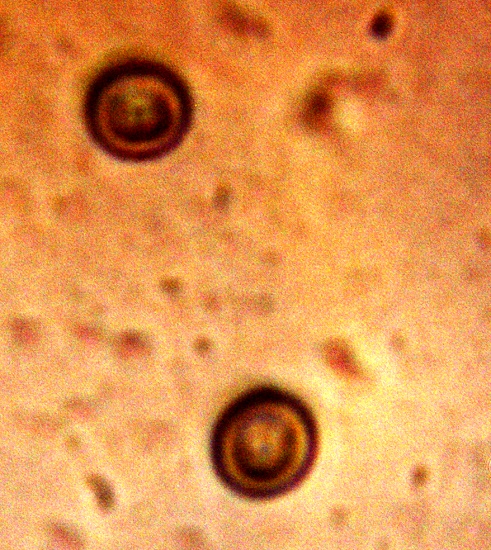
Synthetic Blood Cells (Erythrocytes) from Cross Domain Bacteria (CDB) Culture
Original Magnification 8000x
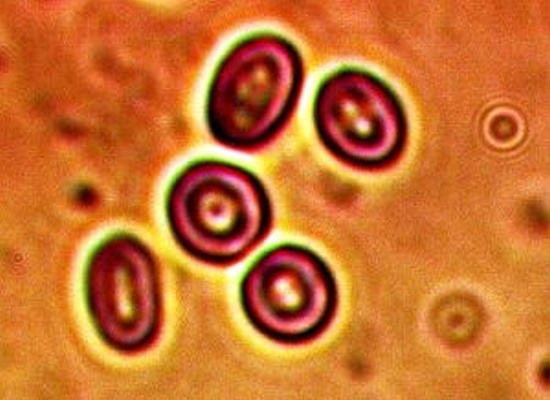
Synthetic Blood Cells (Erythrocytes) from Cross Domain Bacteria (CDB) Culture
CDB can be seen within these cells.
Original Magnification 8000x
Visually we have a case at the onset for the claim of synthetic blood being produced. The manner of production is most remarkable, however, as the synthetic blood cells develop from culture.
One of the issues that arises is that it is quite difficult to say what is “normal” blood anymore. Human blood has been affected on a broad level by the CDB for more than two decades. CDB are omnipresent in human blood.
The photo of “normal” blood in the case shown above seems to be rare now. CI’s research as well as the research of many others now testifies to that account. Coagulated, malformed, or damaged blood structure is the norm, as has been discussed in countless papers. The following example is unfortunately all too common:
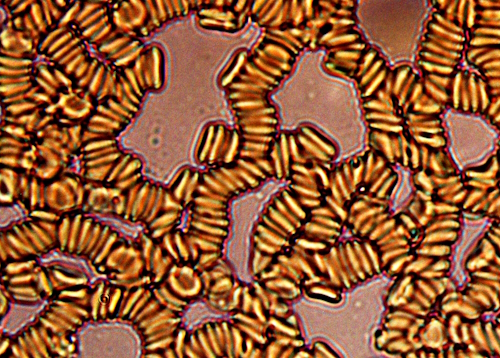
Human blood commonly showing extensive rouleaux and aggregation.
The reference of “normal” can no longer apply.
Original magnification 3200x
_______________
Section II: A Basis Established for the Increased Coagulation of Human Blood:
Summary of Section II:
Red blood cells have a negative charge. This charge causes the cells to repel one another and prevent coagulation. If foreign proteins (i.e., CDB) of a relative positive charge are introduced into the blood it will cause a reduction of this repelling force. The consequence of this is that red blood cells will then be more attracted to one another, causing the increased coagulation of blood.
The essence of this section is that an understanding of the alteration of the electrical charge nature of blood is almost certain to be a critical factor in understanding any increase in blood coagulation. This then further requires an understanding of the electrical nature of any foreign proteins introduced into that blood. The framework for that understanding may now be in place.
_______________
Note: Technical portions of the work may be enclosed in parentheses, and they can be read per preference.
Let’s get a couple of these in place, as they set the stage for a monumental consequence to consider:
((Note: “Red cell membranes have a negative charge (zeta potential) that causes red cells to repel each other. In the presence of increased positively charged plasma proteins such as fibrinogen or immunoglobulins, the negative charge on the red cell surface is diminished, allowing red cells to stick together.” Ref. hematology.org)
_______________
(“The isoelectric point (pI) of a protein is defined as the pH at which the net charge of a protein molecule is zero. Accordingly, proteins are positively charged at a pH below their pI and negatively charged at a pH above their pI. The protein pI varies greatly from extremely acidic to highly alkaline values ranging from about 4.0 to 12.0. Hence, pI values have long been used to distinguish between proteins in methods for protein isolation, separation, purification, crystallization, etc. Amino acid composition of a protein sequence primarily defines its pI, based on the combination of dissociation constant (pKa) values of the constituent amino acids. Out of twenty common amino acids, two amino acids, aspartic acid, and glutamic acid, are negatively charged and three amino acids, lysine, arginine, and histidine, are positively charged at the neutral pH, as defined by their pKa values.”)
Ref. https://www.ncbi.nlm.nih.gov/pmc/articles/PMC8667598/
_______________
(This looks like it may well have one answer. The pH of the culture is on the order of 3.8 (fairly strong acid). The dominant pH of the human blood proteome is 5.3. One primary protein pI of the CDB culture is also determined at 5.3. The pH of the CDB culture is lower than the dominant pI of the blood proteome as well as lower than the CDB culture pI. This means that the blood proteins are being exposed to additional positively charged proteins with the introduction of the CDB. This could explain increased coagulation. – CEC)
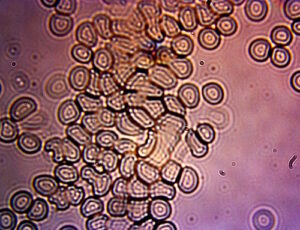
Human blood commonly showing extensive CDB blood damage.
The reference of “normal” can no longer apply.
Original magnification 8000x
Please see The Source of Blood Coagulation: The Cross Domain Bacteria (CDB) (Aug 2023) for one introduction to this problem. As additional insight as to the importance of electrical charge, the following comment was made within this same paper:
_______________
“The change and increase in coagulation/clotting appears to result from an apparent attractive force (i.e., electromagnetic, chemical, etc.) induced, aggravated or enhanced within blood that does show itself to correlate with the advent of the Covid Era.”
Research often has a way of completing a circle with extended gaps in between, and this may be another case of the return to a reasonable proposition.
The essence of this section is that an understanding of the alteration of the electrical charge nature of blood is almost certain to be a critical factor in understanding any increase in blood coagulation. This then further requires an understanding of the electrical nature of any foreign proteins introduced into that blood. The framework for this appears to be in place.
Additional rational, logical and evidence based mitigation strategies will arise from this proposition.
_______________
Section III: The Clotting of Blood
The primary agent that is responsible for the increased coagulation of blood over recent years IS the Cross Domain Bacteria (CDB), a synthetically engineered microbe. The case is made with both observation and extensive analysis.
The complete, specific and documented impact and relationship of the “Covid Era” purported “vaccinations” to the known properties of this microbe remain incomplete and inadequately defined by all parties at this point.
The clotting process consists of the following main stages:
1. The existence of the CBD within the blood (no known exceptions at this time).
2. The successful proliferation of the CDB given adequate nutrients and environmental conditions. This occurs within the human body and can also be accomplished with a culture process.
3. The development of a complex of numerous proteins by the CDB. One primary protein that remains under extensive study is water soluble. This protein(s) therefore has numerous ramifications for human health because of its ease of distribution and assimilation by the body.
4. The production of synthetic blood by this engineered, xenobiotic microbe.
5. The production of polymers that in lay terms corresponds to the world of plastics and synthetic rubber. Beyond synthetic blood, bioplastics are a crucial aspect of the CDB impact upon humans.
6. The development of extensive biological filament growth that, combined with synthetic blood and bioplastics, forms the epitome of a blood clot. The filament and bioplastic growth has a level of distribution throughout the entire body.
7. Exotic and sophisticated protein crystals development, fully indicative of “biological circuitry” are at hand.
8. DNA is also produced by the microbe and it can be isolated within the culture process.
_______________
The study of the progression from CDB to blood has been active for several months.
Observation of the clotting process includes the visual and microscopic examination of:
1. The microbe itself and the interaction with human blood.
2. Extensive study of cultured products from the CDB.
3. The study of synthetic blood and polymer growth from the CDB.
4. The study of blood clots representative of the harm (potentially lethal) that now exists.
Over these previous months, there are approximately a dozen organic analytical techniques that have been applied to approximately three dozen sample variations (primarily of cultured origin) over scores of trials. The analytical methods include:
1. Ultraviolet Light Spectroscopy (UV)
2. Visible LIght Spectroscopy (VIS)
3. Near Infrared Spectroscopy (NIR)
4. Liquid Chromatography (LC)
5. Mid Infrared Spectroscopy (IR)
6. Titration
7. Refractrometry
8. Solubility Analyses
9. Digital Meter Instrumentation
10. pH Analysis
11. Qualitative Chemical Analysis
12. Centrifugation
13. Microscopy
A primary focus of the analytical techniques above is to gain chemical composition information on various states of the culture products and variations over time. The CDB is known to produce close to two dozen variations within the culture, especially of protein variation coupled with polymerization. The final result from this study is a listing of the organic chemical functional groups likely to exist within. Functional groups are the primary building blocks of organic chemistry, and the general nature and reactivity of compounds can be determined from them.
Of the roughly three dozen candidate functional groups or specific biomolecules identified within the samples, the list below is confined to those that demonstrate certainty or a very high probability of existence. This probability is increased with the repetition of functional group type across a variety of sample types, however, all candidates remain under further investigation. The certain or highly probable list (many other functional groups-structures-compounds are NOT to be dismissed) includes:
Vinyl
Methyl
Protein
Aromatic Amine
Alcohol
Alkyl Alcohol
Amide
Polyamide
Aromatic CH
Nucleic Acids – DNA
Vinylidene
Methylene
Hemoglobin
Tyrosine
Amine
The combination of the items in the list above is fraught with possibilities from the organic aspect alone. The inorganic side (e.g., metals) adds another massive layer of complexity to the picture. There is, nevertheless, significant progress that can be made on the question of whether these materials can or do combine to clot the blood. The answer is yes. The CDB is capable of, and does cause the clotting of human blood. It also does more than that.
The general assessment and synthesis of the above information over the past several months is that polymerized proteins are created from the CDB. Proteins are the structures that derive from genetic instruction. Polymers are essentially chains of materials that extend and stabilize mass Examples include plastics, synthetic rubber, polyvinyl, polystyrene, nylon, etc. – these are most definitely not to be in the human body, . A rubber ball or a nylon rope is a polymer, and so is a rubberized or plasticized polymerized blood clot.
The CDB products, with an emphasis upon proteins and polymers, extend throughout the body beyond the blood. This is a inevitable conclusion, both by observation as well as the fact that water soluble proteins distribute quickly and easily throughout the body.
The original CDB metabolism is governed by water soluble proteins. This allows for the ease of distribution as mentioned above. These proteins will gradually form a more vast array of proteins and polymers, some of which will be soluble and others not. Synthetic blood will be a crucial development, as been documented prior. In addition, as we shall see below, DNA does enter the picture in time. There is no other conclusion that can reasonably be drawn other than a transformation of biology is in place, and the human race is a subject to it.
Examples of the synthetic blood and the presence of hemoglobin within it have been shown and written of. What follows are additional macro examples of the types of proteins and polymers formed by the CDB:
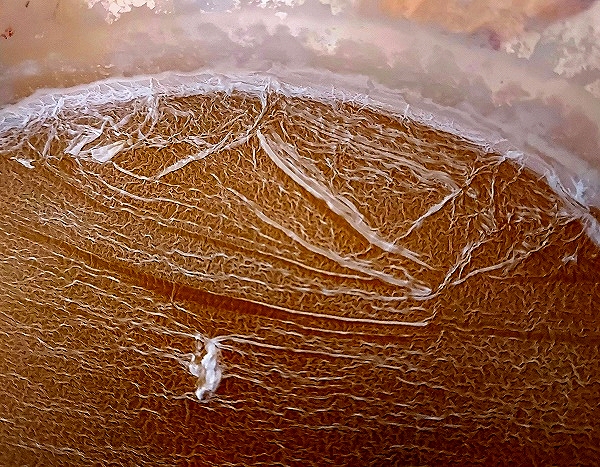
Polymer Formation within Culture by the Cross Domain Bacteria
Synthetic Blood is a component within this polymerized matrix.
Magnification 2x.
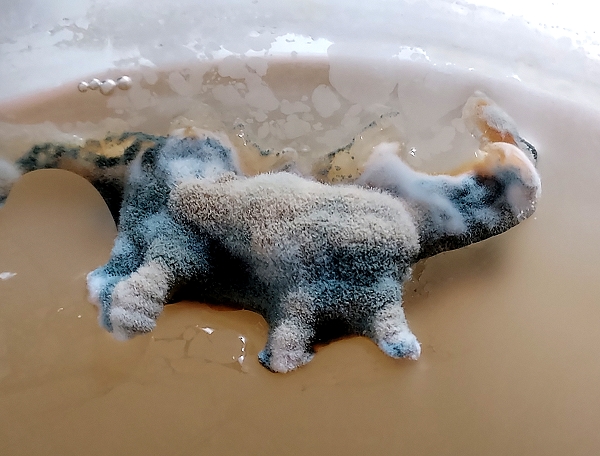
Fundamental Filament Protein Complex formed by the CDB.
Magnification 2x.
The CDB products shown above alone are visually sufficient to justify the claim of clot forming ability by the CDB, let alone with research presented in a previous paper:
Cross Domain Bacteria (CDB) Protein : The Fallout Emerges (Sep 2023)
There is, however, another step that can be taken to confirm that the CDB are responsible for the polymerization of proteins and the clotting of blood.
This involves a comparison of the tabulated chemical characteristics of CDB products (i.e., organic functional groups) with a physical blood clot (of a “rubberized”, or polymeric nature).
(An initial study was reported in the following paper in conjunction with Ana Mihalcea, M.D, PhD (please see Blood Clot Analysis From Living And Deceased Individuals Near Infrared Spectroscopy Shows Multiple Hydrogel Polymer Components – Part 2 of 3 – Dr. Ana Mihalcea With Clifford Carnicom, Jul 2023)).
The blood clot from a deceased individual has been examined again as a part of the studies reported here. This study is confined to the use of NIR. A comparison within this more exhaustive study is shown below:
| CDB Functional Group – Structure Present |
Blood Clot Functional Group – Structure Present |
| Vinyl | Vinyl |
| Methyl | Methyl |
| Protein | Protein |
| Aromatic Amine | Aromatic Amine |
| Alcohol | Alcohol |
| Amide | Amide |
| Polyamide | Polyamide |
| Aromatic CH | Aromatic CH |
| Methylene | Methylene |
| Amine | Amine |
The claim of the ability of the Cross Domain Bacteria (CDB) to clot blood and the fact that it does clot human blood is clear.
_______________
Section IV : DNA Production
The CDB culture produces DNA/nucleic acids. This method to achieve this is not at all obvious and it requires approximately one to two months of progressive culture development. The result is confirmed with the combination of three different methods:
1. UV spectroscopy
2. NIR spectroscopy
3. Qualitative chilled ethanol separation from solution.
The UV study presents significant absorption at 260 nm, known to be representative of DNA existence. The 260 nm/ 280 nm ratio is a common method to assess the concentration ratio of DNA and protein. The UV absorbance profile is similar to that presented within the literature and leads to a DNA concentration level estimate of approximately 15% in solution.
The NIR spectroscopy reveals the existence of the hydroxyl group (dried sample), another signature of DNA presence due to the chemical nature of the base pairs of DNA.
Although visibly minute, the chilled ethanol separation method for DNA is sufficient to produce a visible white layer at the ethanol/solution interface. Such extractions have been repeated many times under CI research in the past and this visual result conforms to previous results (also involving numerous controlled studies of DNA extraction). DNA extraction from the CDB has been successful now on four occasions over the history of CI. A difference in this case is that the DNA is detected within solution vs. extraction from a solid. An attempt to seek identification of an analogous DNA sample to the domain level (biologically speaking) was refused, as accounted for in the paper, A Source of Global Harm: The Cross Domain Bacteria (CDB) Proteins, Sep 2023.
Section V : Beyond the Blood Clot
This section will be introductory only and hopefully will be discussed in more detail at a later time. Logically, and with evidence from more than two decades, there is no cause to conclude that the CDB impact is only upon blood. It produces water soluble protein complexes which distribute easily throughout the entire body. These protein complexes successively polymerize and create synthetic polymers (i.e., bioplastics) within the body as well as the blood.
It is now time to be more direct with the term of “Morgellons”, and its association with the current blood predicament known to originate from the CDB. The damage to the blood and the damage to the body from the condition known as “Morgellons” are of one and the same thing. I have attempted to make this relationship known through some earlier work completed, but it has not yet received the discussion it deserves. I intend to do so more in the future, in honor and recognition of those that have suffered, died, and continue to suffer in a way that should never befall any human being.
Briefly put, the polymerized-bioplastic proteins that form as result of the CDB in the blood clotting are the same polymerized-bioplastic synthetic biology proteins that manifest in the so-called “Morgellons” condition.
This equality can be demonstrated through scores of methods should we care to look at the data, much of which CI has actually already recorded within its history. The situation is now eased considerably, however, with CDB culture materials. NIR will show itself to be a valuable method to disclose the polymer and bioplastic nature of distributed and resident proteins.
The term “Morgellons” is a containment and a marginalization term, or at least it became so over the course of its introduction. Similar methods of manipulating social perception, comprehension and awareness were equally successful in the geoengineering arena. “Morgellons” was presented as a “skin condition” that marginally affected a few people that could, with proper management, be dismissed as “delusional”. Nothing could be further from the truth. “Morgellons” represents an entire assault on the body, including the blood, and I have attempted to make that known. It is the same as the assault we speak of here. It has always been more of a blood borne condition that anything else, but that message was not popularly received. We still have do not have the slightest knowledge of the number of people that have died nor is any attention paid to those that continue to needlessly suffer. It is past time that we accept the direct relationships that exist as well as the plight of our human condition. Our attention span is short, and we are certainly paying for it as a species.
The scope of assault upon the human species is difficult to grasp by many of us, but this does not obviate our responsibility to do so. Your problem to ponder, in the interim, is to ask whether the distribution of a water soluble toxic polymerizing protein complex (via synthetic biology) is restricted to the blood. My answer is no, and history, logic and condition show this to be the truth.
Clifford E Carnicom
Dec 14 2023
Born Clifford Bruce Stewart, Jan 19 1953.

